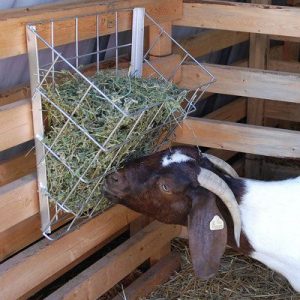Dairy goat farming is a rewarding and profitable venture, provided that the goats are managed properly to maximize milk production.
The foundation of maximizing milk production begins with selecting the right breed. Different breeds of goats have varying capabilities when it comes to milk yield.
Top Dairy Goat Breeds:
- Saanen: Known for their high milk production, Saanen goats are often referred to as the “Holstein of the goat world.” They are large, white goats with excellent udder conformation.
- Alpine: Another high-producing breed, Alpines are hardy and adaptable, making them a popular choice among dairy goat farmers.
- Nubian: Nubians are known for their high butterfat content in milk, which is desirable for cheese making. They are easily recognizable by their long, floppy ears and Roman noses.
- Toggenburg: This breed is also known for good milk production and has a characteristic brown coat with white facial stripes.

Proper nutrition is crucial for maximizing milk production in dairy goats. A well-balanced diet ensures that goats have the necessary nutrients to produce milk efficiently.
Key Nutritional Components:
- Forage: High-quality forage, such as alfalfa hay, provides essential fiber and nutrients. Goats should have access to forage throughout the day.
- Grains and Concentrates: Supplementing with grains and concentrates helps meet the energy demands of lactating goats. Common grains include oats, barley, and corn.
- Protein: Adequate protein intake is essential for milk production. Legume hays, like alfalfa, are excellent protein sources.
- Minerals and Vitamins: Provide a balanced mineral supplement, particularly focusing on calcium, phosphorus, and selenium. Vitamins A, D, and E are also important for overall health and milk production.
- Water: Fresh, clean water should always be available. Water intake directly affects milk yield.

Feeding Practices:
- Consistent Feeding Schedule: Feed goats at the same times each day to maintain a routine.
- Monitor Body Condition: Regularly check the body condition of your goats to ensure they are neither too thin nor overweight. Adjust feed rations accordingly.
- Avoid Sudden Changes: Gradually introduce any changes in diet to avoid digestive upsets.
The genetic potential of your goats plays a significant role in milk production. Selective breeding can help enhance desirable traits.
Breeding Strategies:
- Select High-Yielding Females: Use records to identify and select does that have consistently high milk production.
- Use Proven Bucks: Choose bucks from high-producing lines to improve the genetic potential of your herd.
- Record Keeping: Maintain detailed records of milk production, breeding dates, and kidding histories to make informed breeding decisions.

Breeding Timing:
- Optimal Breeding Season: Goats typically have a seasonal breeding cycle. Plan breeding for the fall to ensure kidding in the spring, which aligns with natural forage availability.
- Pregnancy Management: Ensure pregnant does receive adequate nutrition and care to support the development of healthy kids and prepare for lactation.
Healthy goats are productive goats. Regular health care and welfare practices are essential to maximize milk production.
Health Management:
- Vaccinations: Follow a vaccination schedule to prevent common diseases such as clostridia infections and tetanus.
- Deworming: Regularly deworm your goats to control internal parasites, which can negatively impact health and milk production.
- Hoof Trimming: Trim hooves regularly to prevent lameness and ensure mobility.
- Monitor for Mastitis: Regularly check udders for signs of mastitis, an infection that can drastically reduce milk yield.

Housing and Environment:
- Clean and Dry Housing: Provide a clean, dry, and comfortable environment to reduce stress and prevent diseases.
- Ventilation: Ensure good ventilation to prevent respiratory issues.
- Space: Avoid overcrowding to minimize stress and competition for resources.
On the other note, our company can help you to start by giving you all the necessary information you need to get started if not yet in the business. Please check our online shop, we have all the standard business proposals for different capacities at very a cheap price made by the best agricultural specialists as well as Standard design plans that are made by the best agricultural architects around the globe. please visit our online shop now using the links below to witness by yourself
Design plans (FARM HOUSE DESIGNS – Kimd Construction & Farm Consultants)
Business plans (BUSINESS PLANS & PROPOSALS – Kimd Construction & Farm Consultants)
Welcome back from visiting our shop, hope you have placed your order for any of our products or you can place it after navigating more of our informative articles.
Effective milking management practices are critical to maximizing milk production.
Milking Routine:
- Regular Milking Schedule: Milk goats at the same times each day, typically twice a day, to maintain a consistent supply.
- Cleanliness: Clean the udder and teats before and after milking to prevent infections.
- Gentle Handling: Handle goats gently during milking to reduce stress, which can impact milk let-down.
- Proper Milking Technique: Use proper milking techniques to ensure complete milk removal and stimulate continued production.

Milking Equipment:
- Clean and Sanitize Equipment: Regularly clean and sanitize milking equipment to prevent contamination and mastitis.
- Check for Wear and Tear: Regularly inspect milking equipment for any wear or damage that could affect milking efficiency.

Milk production can be influenced by seasonal changes. Manage your herd to accommodate these variations.
Winter Management:
- Provide Shelter: Ensure goats have adequate shelter to protect them from cold and wet conditions.
- Increase Energy Intake: Adjust feed rations to meet increased energy needs during colder months.

Summer Management:
- Provide Shade: Ensure access to shade and plenty of fresh water to prevent heat stress.
- Monitor for Heat Stress: Be vigilant for signs of heat stress and take appropriate measures to cool your goats.
Conclusion
Maximizing milk production in dairy goats requires a comprehensive approach that includes selecting the right breeds, providing optimal nutrition, managing breeding and genetics, ensuring health and welfare, and implementing effective milking management practices. By paying attention to these key factors, you can enhance milk yield, improve goat health, and increase the profitability of your dairy goat farming operation. With dedication and attention to detail, you can ensure that your dairy goats produce to their fullest potential.




